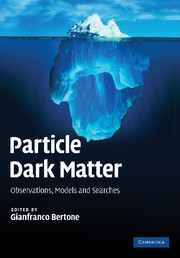Book contents
- Frontmatter
- Contents
- List of contributors
- Preface
- Acknowledgements
- List of symbols and abbreviations
- Part I Dark matter in cosmology
- Part II Candidates
- Part III Collider searches
- Part IV Direct detection
- Part V Indirect detection and astrophysical constraints
- 24 Gamma-rays
- 25 High-energy neutrinos from WIMP annihilations in the Sun
- 26 Indirect dark matter detection with cosmic antimatter
- 27 Multi-wavelength studies
- 28 Particle dark matter and Big Bang nucleosynthesis
- 29 Dark matter and stars
- References
- Index
28 - Particle dark matter and Big Bang nucleosynthesis
Published online by Cambridge University Press: 04 August 2010
- Frontmatter
- Contents
- List of contributors
- Preface
- Acknowledgements
- List of symbols and abbreviations
- Part I Dark matter in cosmology
- Part II Candidates
- Part III Collider searches
- Part IV Direct detection
- Part V Indirect detection and astrophysical constraints
- 24 Gamma-rays
- 25 High-energy neutrinos from WIMP annihilations in the Sun
- 26 Indirect dark matter detection with cosmic antimatter
- 27 Multi-wavelength studies
- 28 Particle dark matter and Big Bang nucleosynthesis
- 29 Dark matter and stars
- References
- Index
Summary
Introduction
In the late 1940s and throughout the 1950s a number of visionary scientists including Alpher, Fermi, Follin, Gamow, Hayashi, Herman and Turkevich attempted to explain nuclear abundance patterns observed in the nearby Universe, such as the peculiar high helium mass fraction YP ≈ 0.25. This initially speculative work on an era of nucleosynthesis (element formation) in an expanding Universe at very high temperature T ∼ 109 K developed slowly but steadily over the coming decades into what is now known as the Standard Model of Big Bang nucleosynthesis (BBN). The idea that the Universe may have undergone a very hot and dense early phase was triggered by the observations of Hubble, in the 1920s, of the recession velocity of galaxies being proportional to their inferred distance from the Milky Way, which were most elegantly explained by a Universe in expansion. The ‘expanding hot Big Bang’ idea received further support from the observation by Penzias and Wilson in 1965 of the cosmic microwave background radiation (CMBR), believed to be the left-over radiation of the early Universe. Detailed observational and theoretical studies of BBN as well as the CMBR and the Hubble flow have developed into the main pillars on which present-day cosmology rests.
BBN takes place between eras with (CMBR) temperatures T ≠ 3 MeV and T ≠ 10 keV, in the cosmic time window t ≠ 0.1–104s, and may be characterized as a freeze-out from nuclear statistical equilibrium of a cosmic plasma at very low (∼10−9) baryon-to-photon number ratio (cf. Section 28.2), conditions which are not encountered in stars.
- Type
- Chapter
- Information
- Particle Dark MatterObservations, Models and Searches, pp. 565 - 585Publisher: Cambridge University PressPrint publication year: 2010
- 1
- Cited by

